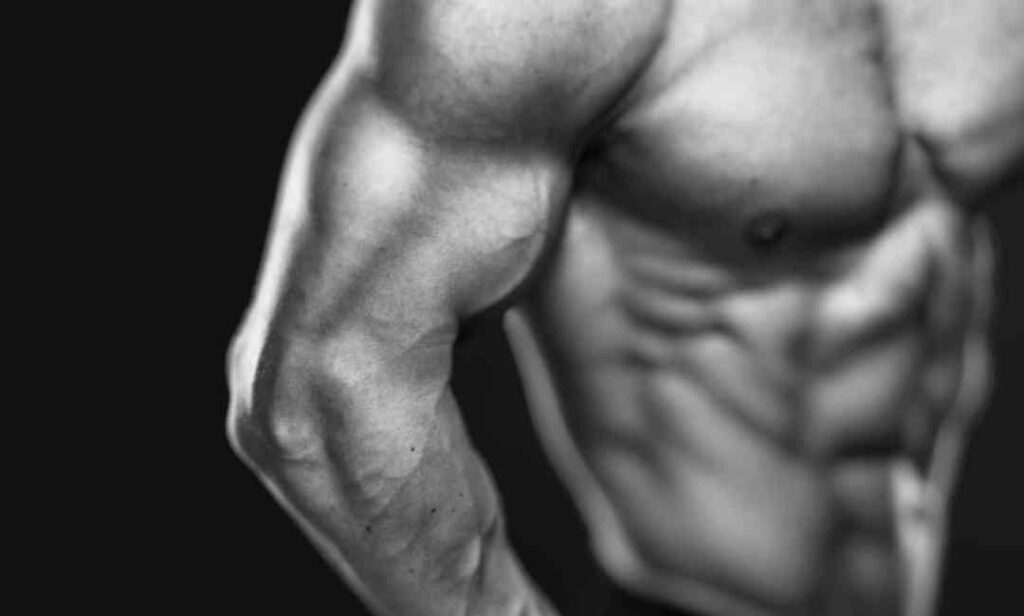When it comes to bodybuilding, muscle imbalances, particularly when one arm is bigger than the other, can affect both aesthetics and functional performance.
If you find yourself in this situation, you must address this issue to prevent further imbalances and potential complications.
Why One Arm Is Bigger Than The Other?
This blog post provides practical steps and expert advice to help you correct muscle imbalances and achieve a more symmetrical upper body.
Is It Normal For One Bicep To Be Bigger?
Yes, it is common for one bicep to be slightly bigger than the other. Many individuals experience mild asymmetry in muscle size throughout their bodies, including the biceps. These minor differences can be attributed to various factors, including genetics, limb dominance, and daily activities.
Genetics: Each person has a unique genetic makeup that influences muscle development. Some individuals may naturally have one bicep slightly larger or more defined than others due to genetic factors.
Limb Dominance: Most people have a dominant hand and arm that they use more frequently in daily activities. The increased use and engagement of the dominant arm can lead to slightly greater muscle mass than the non-dominant arm.
Activities and Movements: Regular physical activities or sports involving one arm more than the other, such as racket sports or throwing, can develop asymmetrical muscle mass. The repetitive use of a specific arm can lead to increased muscle size and strength in that arm over time.
Injury or Rehabilitation: If you have experienced an injury or undergone rehabilitation for one arm, it’s common to observe differences in muscle mass. During recovery, the injured arm may experience muscle atrophy or loss of strength, resulting in noticeable asymmetry.
While minor differences in bicep size are generally considered normal and nothing to be overly concerned about, significant or sudden discrepancies may warrant further attention.
Suppose the size difference is substantial or accompanied by pain, limited range of motion, or functional impairment. In that case, it’s advisable to consult a healthcare professional or a qualified fitness expert. They can assess your situation, provide appropriate guidance, or recommend exercises to address muscle imbalances.
Remember, achieving perfect symmetry in muscle development is challenging for most individuals and only sometimes necessary for overall fitness and strength. Focus on balanced training, proper form, and overall functional fitness rather than obsessing over minor differences in muscle mass.
Related: 7 Reasons: Why Aren’t My Arms Growing
Reasons Behind Uneven Biceps
Imbalanced Training: Inconsistent or imbalanced training can contribute to unequal biceps development. Suppose you primarily focus on exercises that predominantly engage one arm, such as unilateral movements or exercises with poor form. In that case, it can lead to asymmetrical muscle growth.
Overcompensation: Sometimes, when one arm is weaker or less developed, the stronger side tends to compensate by taking on a greater load during exercises. It can lead to further muscle imbalances and uneven bicep development.
Postural Imbalances: Poor posture or alignment can affect muscle development and contribute to unequal biceps. Muscular imbalances caused by postural issues can result in overactive or underactive muscles, leading to asymmetrical growth.
What Are Some Preventable Factors?
Several preventable factors can contribute to uneven bicep development. Addressing and taking proactive steps to prevent these factors can reduce the likelihood of developing significant asymmetry. Here are some key preventable factors:
Proper Form and Technique: Using proper form and technique during exercises is essential for preventing muscle imbalances. Improper form can inadvertently shift the focus onto one arm, leading to unequal biceps development. Seek guidance from a fitness professional to learn the correct form for various exercises and ensure you execute them properly.
Balanced Strength Training: Implementing a well-rounded strength training program that targets all major muscle groups is important for overall symmetry. You promote balanced growth throughout the body, including the biceps, by focusing on compound exercises that engage multiple muscle groups, such as squats, deadlifts, and bench presses.
Addressing Muscle Imbalances: If you notice any early signs of muscle imbalance, such as one arm feeling significantly weaker than the other, take action promptly. Incorporate specific exercises and techniques to target the weak side and promote balance. Consulting with a fitness professional or physical therapist can provide valuable insights and guidance in addressing muscle imbalances effectively.
By paying attention to these preventable factors and adopting a well-rounded approach to training and muscle development, you can minimize the risk of significant asymmetry in your biceps and promote balanced growth throughout your upper body.
Why Is My Non-Dominant Bicep Bigger?
One of the main reasons why a non-dominant bicep is bigger than your dominant bicep is Compensatory Growth. Compensatory growth is a phenomenon that occurs when one part of the body works harder to compensate for the deficiencies or limitations of another part.
In bicep size asymmetry, compensatory growth can occur when the non-dominant arm compensates for the dominant arm’s lack of strength or coordination.
Activities or sports heavily relying on the non-dominant arm can contribute to this compensatory growth. For example, suppose you frequently engage in tasks that require significant use of your non-dominant arm, such as carrying heavy objects, pushing or pulling movements, or performing manual labor. In that case, the non-dominant arm may be subjected to greater stress and workload than the dominant arm.
The increased demand on the non-dominant arm prompts the muscles to adapt and grow in response to consistent and intense activity. Over time, this can result in greater muscle development in the non-dominant bicep, leading to a noticeable difference in size between the two arms.
Compensatory growth is a natural response of the body to meet functional demands. However, excessive or unbalanced reliance on the non-dominant arm can lead to overuse injuries or further imbalances in the musculoskeletal system.
Suppose you want to address the size difference between your non-dominant and dominant biceps. In that case, focusing on exercises that engage both arms simultaneously (bilateral exercises) to ensure equal stress and stimulation may be helpful. It can help promote balanced muscle growth and prevent further compensatory growth in the non-dominant arm.
Additionally, incorporating exercises targeting the weaker or less developed arm (unilateral exercises) can help bring it up to par with the dominant arm. By implementing a well-rounded training program that includes both bilateral and unilateral exercises, you can work towards achieving a more symmetrical and balanced bicep development.
Related: Unveiling The Reasons Behind Small Tricep Big Bicep
Rules To Follow When Trying To Fix Bicep Imbalance
When addressing a bicep imbalance, it’s important to approach it with a well-rounded strategy focusing on strength and muscle development. Here are some key rules to follow when finding an answer for how to fix uneven arms
Assess the Imbalance:
- Take the time to thoroughly assess the extent of the bicep imbalance.
- Compare both biceps’ size, shape, and strength visually and through measurements.
- Pay attention to any noticeable differences in appearance or performance between the two arms.
By understanding the specific nature of the imbalance, you can tailor your approach accordingly and set realistic goals for improvement.
Focus on Symmetrical Training: Make sure your workout routine includes exercises that engage both arms equally. Bilateral exercises involving both arms working together should be a cornerstone of your training. Examples include barbell curls, dumbbell curls performed simultaneously with both arms, or push-ups. By prioritizing symmetrical movements, you promote overall balance and prevent further imbalance.
Implement Unilateral Exercises: In addition to symmetrical training, incorporate unilateral exercises that target the weaker or smaller bicep specifically. Unilateral exercises isolate each arm, allowing you to focus on the weak side and promote individualized growth. Examples include dumbbell curls, hammer curls, concentration curls, or single-arm cable curls. Start your workouts with these exercises using the weaker arm to ensure it receives dedicated attention and effort.
Prioritize the Weaker Arm: Give extra attention and priority to the weaker arm during your workouts. By performing exercises with the weaker arm first, you ensure it receives a higher focus and energy level. This approach prevents the stronger side from compensating for the weaker arm’s limitations and promotes balanced development. Additionally, aim to perform more sets or repetitions with the weaker arm to provide additional stimulus for growth.
Use Progressive Overload: Apply the principle of progressive overload to both arms. Progressive overload involves gradually increasing the demands placed on your muscles over time. It can be achieved by gradually increasing your exercise’s weight, resistance, or intensity. By progressively challenging both biceps, you ensure balanced growth and prevent one arm from lagging behind the other. Keep track of the weights and reps you use for each arm to ensure progressive overload is applied consistently.
Allow for Adequate Rest and Recovery: Rest and recovery are essential for muscle growth and repair. Provide sufficient rest periods between workouts for both arms to recover. Overtraining can hinder progress and increase the risk of injury. Listen to your body and give it the time to rebuild and adapt. Adequate sleep, proper nutrition, and hydration are crucial for effective recovery.
Monitor and Track Progress:
- Regularly assess and track your progress to determine the effectiveness of your training approach.
- Take measurements of both arms’ size and strength at regular intervals.
- Keep a workout journal to record weights, reps, and noticeable changes.
Monitoring your progress allows you to make necessary adjustments to your training program. It helps you stay motivated by seeing the improvements over time.
Seek Professional Guidance: If you’re uncertain about the best approach to address your bicep imbalance, consider seeking guidance from a fitness professional or physical therapist. They can provide expert advice, assess your situation, and design a personalized training plan tailored to your needs. They may also recommend specific exercises, modifications, or additional techniques to help correct the imbalance effectively and safely.
Remember that addressing a bicep imbalance takes time, patience, and consistency.
Related: How To Get Big Arms If Your Skinny
One Arm Is Bigger Than The Other: How To Fix Uneven Arms?
To even out your biceps and balance your arms, it’s essential to include exercises focusing on each arm separately while also getting them to work together. Here are some exercises that can help you achieve that symmetry:
Unilateral Dumbbell Curls:
- Hold a dumbbell in one hand and stand with your feet shoulder-width apart.
- Keep your back straight and curl the weight towards your shoulder while keeping your elbow close to your side.
- Slowly lower the weight and repeat for the desired number of repetitions.
- Perform the same number of sets and repetitions with the weaker arm as you do with the stronger arm.
Hammer Curls:
- Hold a dumbbell in each hand with your palms facing your torso.
- Keep your elbows close to your sides and curl the weights up while maintaining a neutral grip (palms facing each other).
- Focus on squeezing your biceps at the movement’s top and slowly lowering the weights.
This exercise targets both the biceps and the brachialis muscles, which can help create a more balanced appearance.
Concentration Curls:
- Sit on a bench or chair with your feet flat on the floor.
- Hold a dumbbell in one hand and rest your elbow on the inside of your thigh, near your knee.
- With your palm facing up, curl the weight towards your shoulder while keeping your upper arm stationary.
- Focus on fully contracting your bicep at the top of the movement and then lower the weight back down in a controlled manner.
- Repeat for the desired number of repetitions before switching to the other arm.
Concentration curls isolate and emphasize each bicep individually, helping to address imbalances.
Preacher Curls:
- Using a preacher curl bench or an incline bench, position your upper arms against the pad and hold a barbell or dumbbell with an underhand grip.
- Keep your elbows on the pad and curl the weight towards your shoulders, focusing on contracting your biceps.
- Slowly lower the weight back down to the starting position and repeat.
Preacher curls are effective at targeting the biceps while reducing the involvement of other muscles, allowing for better isolation of each arm.
Alternating Dumbbell Curls:
- Hold a dumbbell in each hand with your palms facing forward.
- Curl one arm up towards your shoulder while keeping the other stationary, then alternate arms for each repetition.
- Focus on maintaining proper form and a controlled tempo throughout the movement.
This exercise ensures both arms are engaged equally and can help correct imbalances over time by allowing each arm to work independently.
Barbell Curls:
- Stand with your feet shoulder-width apart, holding a barbell with an underhand grip and your palms facing forward.
- Keep your elbows close to your sides and curl the barbell towards your chest while maintaining a controlled movement.
- Squeeze your biceps at the top of the curl and then slowly lower the barbell back down.
Barbell curls engage both arms simultaneously and can be an effective exercise for overall balanced bicep development.
Resistance Band Curls:
- Anchor a resistance band to a sturdy object at about waist height.
- Hold one band end in each hand, with your palms facing forward.
- Step back to create tension in the band and curl your hands up towards your shoulders, focusing on engaging both biceps equally.
- Control the resistance band as you lower your hands and repeat for the desired repetitions.
Resistance band curls provide variable resistance throughout the movement, challenging your biceps and helping to strengthen and balance both arms.
Related: How To Do Bicep Curl
Remember to maintain proper form throughout each exercise, focusing on controlled and deliberate movements. Start with a weight or resistance level that allows you to perform the exercises with good form, gradually increasing the challenge as your strength improves. Consistency, proper nutrition, and sufficient rest and recovery are crucial for achieving balanced biceps.
Are Uneven Biceps Dangerous?
Uneven biceps themselves are not typically considered dangerous. However, underlying factors contributing to muscle imbalances, such as weakness, poor posture, or muscular imbalances in other body areas, can increase the risk of injury or discomfort.
Muscle imbalances may affect the alignment and function of joints, potentially causing issues such as joint pain, instability, or movement restrictions.
Additionally, if the imbalance is significant and persists over a long period, it could affect your overall physical performance and aesthetic appearance.
Muscle size or strength imbalances can affect the symmetry and proportion of your physique, which may concern some individuals.
Common Mistakes In Training That Lead To Uneven Biceps
Several common mistakes are worth mentioning regarding training that can lead to uneven biceps. Avoiding these pitfalls can reduce the likelihood of developing muscle imbalances. Here are some mistakes to be aware of:
Neglecting Unilateral Exercises: Focusing solely on bilateral exercises (exercises that involve both arms simultaneously) can result in the stronger side compensating for the weaker one. Neglecting unilateral exercises (exercises that target each arm individually) can lead to unequal biceps development. Incorporating both bilateral and unilateral exercises into your training routine is important.
Poor Form and Technique: Using improper form and technique during bicep exercises can compromise the workout’s effectiveness and potentially lead to muscle imbalances.
Ensure you have proper posture, alignment, and range of motion throughout each exercise to engage the biceps evenly and avoid over-reliance on the stronger arm.
Overcompensating with the Dominant Arm: Many people have a dominant side that naturally tends to be stronger. It’s common to unknowingly rely more on the dominant side during exercises, leading to unequal biceps stress distribution and muscle development. Be mindful of your form and consciously focus on using both arms equally during exercises.
Lack of Progressive Overload: Progressively increasing the demands placed on your muscles is essential for balanced growth. Failing to implement progressive overload by consistently challenging your muscles with increased weight, resistance, or intensity can result in stagnation and imbalances. Gradually increase the load over time to stimulate muscle growth in both arms.
Ignoring Other Muscle Groups: Overemphasizing bicep training while neglecting other muscle groups, such as the triceps, back, and shoulders, can create imbalances.
A well-rounded workout routine incorporating exercises for multiple muscle groups promotes balance and symmetry.
Inconsistent Training: Consistency is key for balanced muscle development. Irregular or sporadic training can hinder progress and allow imbalances to persist.
Stick to a regular training schedule, including bilateral and unilateral exercises, to ensure consistent stimulation and growth in both biceps.
Insufficient Rest and Recovery: Rest and recovery are crucial for muscle growth and repair. Pushing your muscles too hard with insufficient recovery time can prevent progress and increase the risk of injury.
Ensure you provide ample rest periods between workouts and prioritize proper sleep, nutrition, and hydration to support optimal recovery.
By avoiding these common mistakes and adopting a well-rounded, balanced approach to training, you can reduce the likelihood of developing uneven biceps and promote symmetrical muscle development throughout your arms.
A Word From Blogzah
Uneven biceps can be addressed through targeted exercises, proper training techniques, and a balanced approach to muscle development.
By understanding the contributing factors and implementing corrective measures, you can work towards achieving balanced and symmetrical biceps.
Stay consistent, patient, and seek professional guidance to optimize your progress.
Note: Get the most out of every workout with Pre-workouts.
FAQs
What Causes Muscular Imbalances?
Muscular imbalances can be caused by several factors, including uneven biceps training or neglecting certain muscle groups, favoring one side of the body, poor posture, repetitive movements, previous injuries, or genetic predisposition. These factors can lead to muscle strength, size, and coordination differences.
Can Uneven Biceps Develop for Reasons Unrelated to Training?
Yes, uneven biceps can develop for reasons unrelated to training. Some individuals may naturally have slight asymmetry in their muscle development due to genetic factors.
Hormonal imbalances, certain medical conditions, or injuries can also contribute to unequal biceps. However, training and exercise can help minimize and correct these imbalances to a certain extent.
Who Usually Develops Muscular Imbalances?
Muscular imbalances can occur in individuals of all fitness levels and backgrounds. They are common among athletes or individuals who engage in repetitive movements or sports that favor one side of the body, such as tennis or golf.
People who have poor posture, sedentary lifestyles, or a lack of balanced strength training are also susceptible to developing muscular imbalances. It’s important to address these imbalances through targeted exercises and corrective strategies.
















